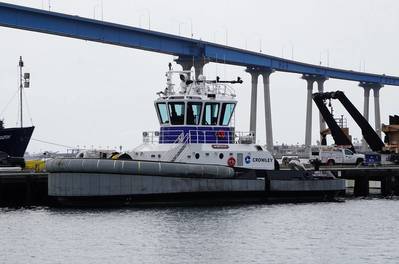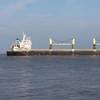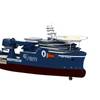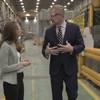On Board the eWolf: The First Electric Tugboat in the US
Crowley Maritime Corporation has owned and operated a lot of vessels since its founding in 1892. But the latest vessel to join its fleet is unlike any other that has come before it.
Crowley’s new harbor tug, eWolf, is unique in that it runs 100% powered by batteries, not diesel engines, meaning it produces zero emissions and nearly no noise. Not only is the vessel the first fully electric tug in the Crowley fleet, but it is also the first of its kind in the United States.
Faced with stricter regulations and commercial pressure to prioritize environmental, social and governance (ESG) objectives, vessel owners and operators have been exploring options to reduce their emissions. A growing number of hybrid- and full-electric ferries and tugs have been sprouting up across the globe.
“When we started this journey, the concept of an electric tug was just starting to kick off,” said Paul Manzi, vice president of ship assist and escort at Crowley. “There was some work going on in New Zealand and in Europe, and we began to think it was possible to do it here as well.”
So, Crowley set out to produce an electric tug of its own, and in 2021—the same year the company announced its commitment to reach net-zero emissions by 2050—its engineering services division unveiled the groundbreaking tug design. ABB was brought on as systems integrator, and Coden, Ala. shipbuilder Master Boat Builders began building the vessel later that year.
The result of these efforts is the 82-foot-long tug eWolf, built to ABS class and compliant with U.S. Coast Guard Subchapter M regulations. Officially delivered to Crowley in January of this year, the vessel was heavy lifted from Alabama through the Panama Canal and floated in Ensenada, Mexico. From there, eWolf transited under its own power up to its homeport, San Diego, where it sits today, ready to enter service at the Tenth Avenue Marine Terminal.
Building the beast
On the outside, eWolf has the appearance of a standard tug. On the inside, it’s something altogether different. “A tug is a tug in a lot of ways,” said Garrett Rice, president at Master Boat Builders. “The eWolf’s hull and structure are very similar to those of some other tugs we've built and we'll continue to build. But once we got into the outfitting stage, everything changed real quick.”
The vessel is equipped with an integrated electrical propulsion package provided by ABB, a 6.2 MWh Orca battery energy storage system from Corvus Energy, two 2,100 kW RAMME motors, and two electrically driven Schottel RudderPropellers type SRP 430 LE azimuthing thrusters, featuring propeller diameters of 2.5 meters. The vessel also has two small John Deere generators on board for emergency use and to enable long distance transits at reduced speeds.
Bruce Strupp, vice president of marine systems for U.S. and Canada at ABB Marine & Ports, described the key pieces of technology that are core to an ABB solution for hybrid and zero-emission vessels. “The first is our Onboard DC Grid architecture. All the power sources integrate into the Onboard DC Grid, which distributes them to all the consumers throughout the vessel,” he said. “Our DC grid is a closed-bus configuration because it allows for more operational redundancy and safety for the vessel.
“The architecture that layers on top of that is the automation system, our Power and Energy Management System (PEMS). It basically controls the flow of all the power feeding into the DC grid, and then also all the power that's swung to all the consumers,” Strupp said.
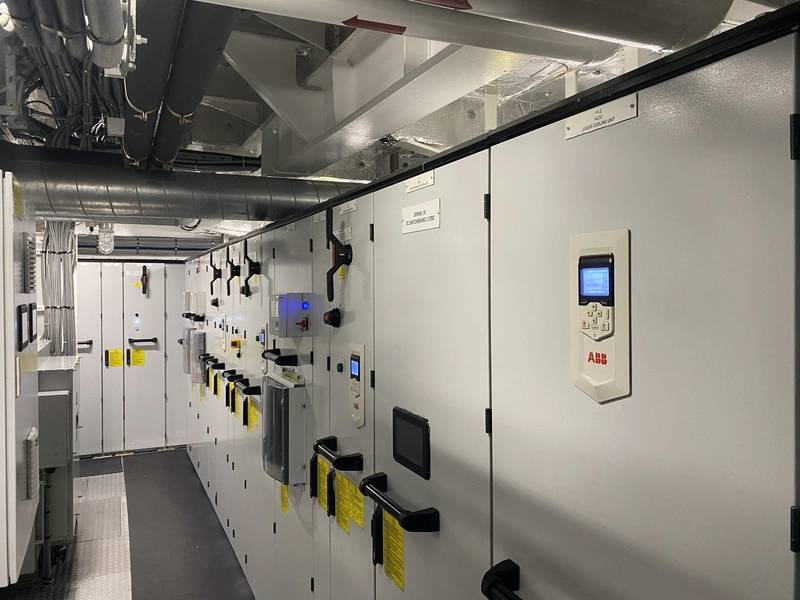 The eWolf’s power integrates into ABB’s DC grid architecture, which distributes to all the consumers throughout the vessel. (Photo: Eric Haun)
The eWolf’s power integrates into ABB’s DC grid architecture, which distributes to all the consumers throughout the vessel. (Photo: Eric Haun)
The use of electrical power on commercial vessels is not new, and Rice and his team have been building boats that incorporate this technology for years—especially for the offshore market, where diesel-electric has become commonplace. “A lot of the big cables, terminations, variable frequency drives, etc., that go into the system, we’ve dealt with them before,” Rice said. “We just had, in our case, 220 feet of real estate to deal with them. And so, here [with the eWolf], we had maybe 79 feet to put a lot of that same equipment.”
A relative lack of space became a challenge when trying to install the cables in particular, Rice said. “Those big power cables can only bend so much because of how thick they are,” he explained. “Typically, the grating height of the machinery space off the tank top is somewhere around 12 to 16 inches. If you've got 14 inches and the bend rate's 13 inches, you've got a really, really tight spot and difficulty getting the cable in.”
“On the eWolf, there's high voltage everywhere,” Rice said. “We really had to think through how to make sure we have separation of cables, more so than we do on a traditional tug.”
The eWolf turned out to be a learning experience for all of the partners involved in creating it. “From a planning and a design standpoint, there's a lot of nuances that we learned in this tug that we will apply to the next one—different things that we have to think about that we typically don't on a traditional tug,” Rice said.
Rice stressed the importance of teamwork between the shipyard, electrical integrator, designer and production engineering team. “Everybody needs to know what each other's doing as early as possible,” he said. “Early collaboration between partners is key to the success of any project, but in particular something like the eWolf that is this technical and first-of-its-kind.”
The cost of cutting emissions
Notably, the eWolf is an expensive tug. Crowley officials declined to disclose a dollar figure, but said the new vessel costs about double the price of a conventional tugboat with similar power output.
While much of the project funds came from privately-held Crowley, the project also obtained a significant amount of grant funding aimed at helping maritime companies achieve cleaner operations. To bring the eWolf to life, Crowley partnered with the San Diego County Air Pollution Control District, the California Air Resources Board (CARB), the Port of San Diego, the U.S. Environmental Protection Agency (EPA) and the U.S. Maritime Administration (MARAD), which all provided financial support and other resources.
“This tug becomes somewhat commercially viable because of the grant process,” Manzi said. “Unlike a ferry service that's paid for by tax dollars, we have to collect fares and tariffs from the shipowners. Right now, the technology is out over market. So, we're working to true that up.”
“The big driver [to produce the eWolf] was the reduction in emissions,” Manzi said, noting that in 10 years’ time, Crowley expects the eWolf will have saved 178 tons of nitrogen oxides, 2.5 tons of diesel particulate matter and 3,100 metric tons of carbon.
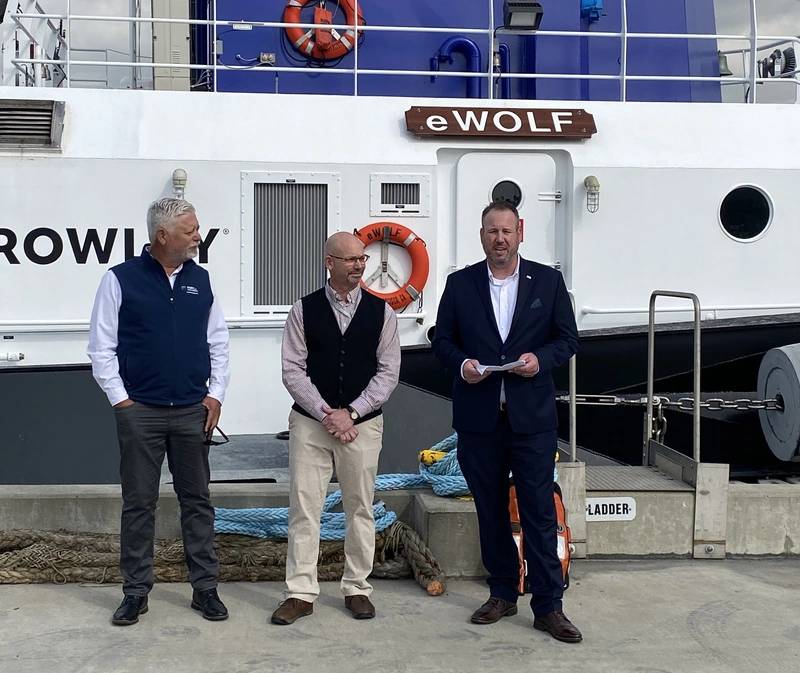 From left: Chairman Frank Urtasun, Board of Port Commissioners, Port of San Diego; Paul Manzi, Vice President, Crowley Shipping; Bruce Strupp, Vice President of Marine Systems US & Canada, ABB Marine & Ports (Photo: Eric Haun)
From left: Chairman Frank Urtasun, Board of Port Commissioners, Port of San Diego; Paul Manzi, Vice President, Crowley Shipping; Bruce Strupp, Vice President of Marine Systems US & Canada, ABB Marine & Ports (Photo: Eric Haun)
Receiving a charge
While eWolf is already in San Diego, ready to go, its official entry into service has been put on a short hold as it awaits the completion of a specially designed shore charging system, the construction of which has fallen behind schedule.
“When you're out on the leading edge of these technologies, everything has to catch up,” Manzi said. “Permitting has to catch up, regulation has to catch up, standards have to catch up. And we've faced all three of those challenges in getting the charge. The boat actually went easier.”
The microgrid charging facility features a pair of Corvus Orca BOB (battery on board) systems, the containerized version of the Corvus Orca ESS, each with storage capacity of almost 1.5 MWh, for a total capacity of 2,990 kW. The station is intended to operate on off-peak hours from the local energy grid, and it includes a solar power array to support renewable energy use, as well as battery monitoring system, HVAC and firefighting and detection technology.
Through a lot of hard work and collaboration with partners such as the Port of San Diego as well as utility provider San Diego Gas & Electric (SDGE), the regulatory and logistical hurdles have been overcome, and construction is progressing at a strong pace, Manzi said. “We expect to have the charging station ready to operate by April 15.”
 eWolf features a 6.2 MWh Orca battery energy storage system from Corvus Energy (Photo: Eric Haun)
eWolf features a 6.2 MWh Orca battery energy storage system from Corvus Energy (Photo: Eric Haun)
Operating the tug
Capt. Josh Ferguson previously served as the master of Crowley’s tug Tioga before taking the helm aboard the eWolf. He said he’s a fan of the new vessel but that operating it takes some getting used to. “It’s much different,” Ferguson said. “You don’t realize how many audio cues that you have available [from the engines] aboard a traditional vessel. But now that you have none, and then couple that with the power of electric motors—they spool up very fast like a Tesla does—you have to change the way you operate the vessel in general. A little bit of a learning curve, but I’m excited about it.”
Without engine noise or vibration, eWolf delivers a significantly smoother ride overall. Importantly, it can also perform on the job, offering 70-ton bollard pull capability. On deck, the tug sports two Markey model DEPC-48 electric hawser winches.
The tug is intended to perform two evolutions per day, and its charging time is about 4.5 hours, Manzi said. “We expect that the vessel will always have sufficient charge to be running at any time.”
The eWolf is a dayboat with a three-person crew—a captain, deckhand and engineer, and it will remain that way for some time. But Manzi said the scope of mariner duties could change down the road. “What do we really need an engineer to do? There are no moving parts. So, how does that [role] change? How does that change where we work? This is a conversation for 5, 6, 10 years in the future.”
 Capt. Josh Ferguson, master of the eWolf (Photo: Eric Haun)
Capt. Josh Ferguson, master of the eWolf (Photo: Eric Haun)
Autonomy testbed
Innovation aboard the eWolf extends well beyond its propulsions system. Today, eWolf’s Certificate of Inspection (COI) is for standard operation, without any autonomous or remote-control functions, but the vessel is equipped with technology from ABB to enable autonomous operations in the future.
The vessel’s current onboard systems can provide passive situational awareness. The next step would be supervised autonomous transits with a captain on board before eventually progressing to remote supervised autonomous transits, said Eileen Tausch, senior electrical engineer - research and development at Crowley.
ABB Ability Marine Pilot Vision fuses input from cameras and other sensors to create an augmented view of the vessel’s surroundings that provides enhanced decision support for things such as docking assistance, obstacle detection and collision avoidance. eWolf has six cameras and then a pan-tilt-zoom camera, LIDAR, W-band radar and AIS, all feeding into the system.
“We're really trying to empower the captain and crew with the best information possible so they can use their skills and training and operate the vessel successfully,” said Drew Orvieto, senior manager, passenger vessels, marine and ports at ABB Marine & Ports. “The system is set up as a buddy on the bridge to provide whatever it finds in sensory inputs that will be helpful for a navigator for safe transit.”
“If Pilot Vision is the eyes and some of the brain, then [ABB Ability Marine Pilot Control] is the muscle that puts this to the water,” Orvieto said. “Pilot Control is what will enable autonomous and remote operations down the road.”
Tausch stressed that Crowely is working with its working with ABB to progress the technology in slow, phased approach, while seeking crew feedback through every step of the process. “Our main goal is to improve mariner safety and asset efficiency. . . Where we're focusing currently is the transit to and the transit from [a job],” said. “The actual ship assist or escort operation, I don't even see that on my timeline; that's a ways out.”
In San Diego, eWolf’s transits will typically run 20-30 minutes, “not the optimal operation to really see a lot of benefit,” Tausch said, but noted there is “a lot of potential” elsewhere, like in the Pacific Northwest, where transits can be six or seven hours.
Crowley and ABB are using the eWolf as a testbed for this technology, working together to not only develop and trial the technology, but also navigate regulatory hurdles as the International Maritime Organization (IMO) continues to make headway on developing its Maritime Autonomous Surface Ships (MASS) Code, due to take effect in 2025.
“[The evolution] is step-by-step with crew on board. As the technology proves itself to the level of Coast Guard and class satisfaction, then we can start to investigate higher levels of functionality,” Orvieto said.
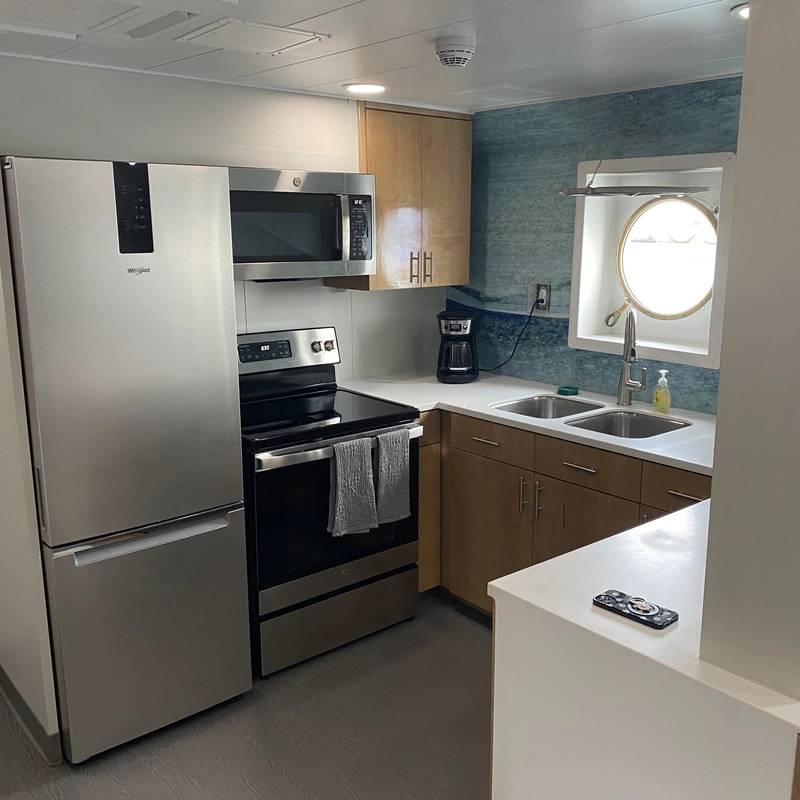 On board the eWolf, Crowley’s focus on environmental impact extended well beyond the innovative propulsion system. Sustainable materials were incorporated as much as possible throughout the vessel’s interior spaces (Photo: Eric Haun)
On board the eWolf, Crowley’s focus on environmental impact extended well beyond the innovative propulsion system. Sustainable materials were incorporated as much as possible throughout the vessel’s interior spaces (Photo: Eric Haun)



